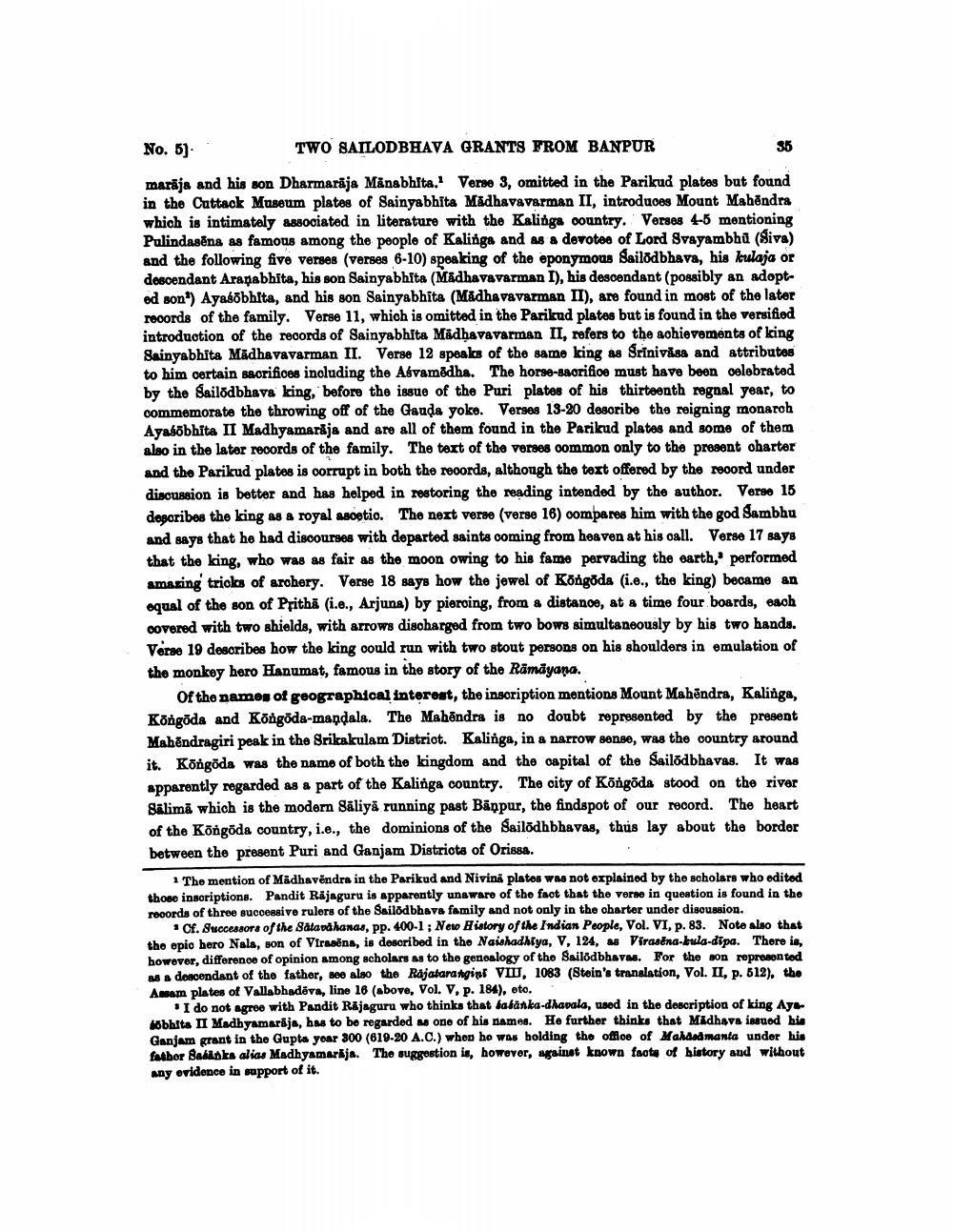________________
No. 5)
TWO SAILODBHAVA GRANTS FROM BANPUR
marāja and his son Dharmaraja Månabhita. Verse 3, omitted in the Parikud plates but found in the Cattack Museum plates of Sainyabhita Madhavavarman II, introduces Mount Mahăndra which is intimately associated in literature with the Kalinga country. Verses 4-5 mentioning Pulindasēna as famous among the people of Kalinga and as a devotee of Lord Svayambhu (Siva) and the following five verses (verses 6-10) speaking of the eponymous Sailodbhava, his kulaja or descendant Aranabhita, his son Sainyabhita (Madhavavarman I), his descendant (possibly an adopted son“) Ayasőbhita, and his son Sainyabhita (Madhavavarman II), are found in most of the later rocords of the family. Verse 11, which is omitted in the Parikud plates but is found in the versified introduction of the records of Sainyabhita Madhavavarman II, refers to the achievements of king Sainyabhita Madhavavarman II. Verse 12 speaks of the same king as Srinivasa and attributes to him certain sacrifices including the Asvamódha. The horse-sacrifice must have been celebrated by the Sailodbhava king, before the issue of the Puri plates of his thirteenth regnal year, to commemorate the throwing off of the Gauda yoke. Verses 18-20 desoribe the reigning monarch Ayasobhita II Madhyamardja and are all of them found in the Parikud plates and some of them also in the later records of the family. The text of the verses common only to the present charter and the Parikud plates is corrupt in both the records, although the text offered by the record under discussion is better and has helped in restoring the reading intended by the author. Verso 15 describes the king as a royal ascetio. The next verse (verse 16) compares him with the god Sambhu and says that he had discourses with departed saints coming from heaven at his call. Verse 17 says that the king, who was as fair as the moon owing to his fame pervading the earth,' performed amazing tricks of archery. Verse 18 says how the jewel of Kongoda (i.e., the king) became an oqual of the son of Prithā (i.e., Arjuna) by piercing, from a distance, at a time four boards, each covered with two shields, with arrows discharged from two bows simultaneously by his two hands. Verse 19 describes how the king oould run with two stout persons on his shoulders in emulation of the monkey hero Hanumat, famous in the story of the Rāmāyana.
Of the names of geographical interest, the inscription mentions Mount Mahöndra, Kalinga, Köngöda and Köngöda-mandala. The Mahēndra is no doubt represented by the present Mabēndragiri peak in the Srikakulam District. Kalinga, in a narrow sonse, was the country around it. Köngöds was the name of both the kingdom and the capital of the Sailodbhavas. It was apparently regarded as a part of the Kalinga country. The city of Köngöda stood on the river Salimā which is the modern Säliyā running past Bāņpur, the findspot of our record. The heart of the Köngöda country, i.e., the dominions of the Sailodhbhavas, thus lay about the border between the present Puri and Ganjam Districts of Orissa.
1 The mention of Madhavendra in the Parikud and Niviná plates was not explained by the scholars who edited those insoriptions. Pandit Rajaguru is apparently unaware of the fact that the verse in question is found in the records of three Successivo rulers of the Sailodbhava family and not only in the charter under discussion.
• Of. Successors of the Satandhanas, pp. 400-1 ; New History of the Indian People, Vol. VI. p. 83. Note slao that tho opio horo Nala, son of Virasens, is described in the Naishadhiya, V, 124, as Viraadna-bula dipa. There is, however, difference of opinion among scholars as to the genealogy of the Sailodbhava. For the son represented
a doncendant of the father, we also the Rajatarangint VIII, 1083 (Stein's translation, Vol. II, p. 612), the Assam plates of Vallabhadova, line 16 (above, Vol. V, p. 184), eto.
I do not agree with Pandit Rajaguru who thinks that ladanka-dhavala, maod in the description of king Ayo 1bbhita II Madhyamarija, bus to be regarded as one of his names. He further thinks that Midhava issued his Ganjam grant in the Gupta year 300 (619-20 A.C.) when he was holding tho office of Mahdad manta under his fathor Bakanka alias Madhyamarija. The suggestion is, however, against known facts of history and without any evidence in support of it.




